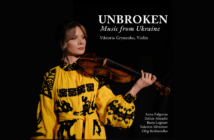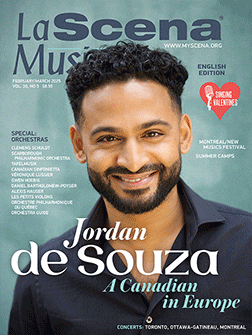
This page is also available in / Cette page est également disponible en:
![]() Francais (French)
Francais (French)
The 2012 film A Late Quartet is largely built around the preparation and performance of Beethoven’s Quartet in C-sharp minor, op. 131. The film has been praised on every level — the acting in particular. The actors, however, are not musicians! The actual sound of the movie’s fictional Fugue String Quartet was provided, most effectively, by the Brentano String Quartet.
In the movie’s final scene the ensemble’s cellist (actor Christopher Walken) stops the performance and explains to the audience that he is no longer able to meet the music’s challenges. (He has Parkinson’s disease.) Anticipating that he might not be able to complete the performance, he and his colleagues have engaged a replacement, a cellist portrayed on screen by the Brentano’s real cellist, Nina Lee. When the musicians resume playing, Lee really digs in, making the deportment of the other players seem staid by comparison.
I asked Brentano first violinist Mark Steinberg if Lee is always that animated. “Oh yes, she certainly is!” he replied, “Though I think we’re all like that to some extent.”
Along with Steinberg and Lee, violinist Serena Canin and violist Misha Amory make up the Brentano Quartet. All except Lee have been members since its beginning in 1992. She joined in 1997, replacing cellist Michael Kannen who left when his wife was injured in an automobile accident. Kannen has occasionally played with the quartet since then, in works that require a second cello, Schubert’s C major Quintet for example. He also substituted for Lee when she was pregnant.
The ensemble is based in New York and its members often do individual work within a day’s drive of the city. Lee, for example has played in the Marlboro and Tanglewood Festivals. Holding a Master’s degree from Julliard (all four Brentano players are Julliard graduates), she teaches at Princeton and Columbia. She has worked with many prominent musicians, including violinist/conductor Jaime Laredo and pianist Mitsuko Uchida.
Her colleagues have similarly impressive résumés. First violinist Steinberg has participated in chamber music festivals in Holland, Germany, Austria, and France. His solo appearances with several orchestras, London’s Philharmonia and the Los Angeles Philharmonic among them, have been warmly received. A contemporary music advocate, Steinberg has worked closely with many composers and has performed with such 20th-century music ensembles as the Guild of Composers, the Da Capo Chamber Players, Speculum Musicae, and Continuum, with which he has recorded and toured extensively in the US and Europe.
Misha Amory won the 1991 Naumburg Viola Award and has been active as a soloist and chamber musician since then. His many prestigious performances include the Marlboro Festival, the Seattle Chamber Music Festival, the Vancouver Festival, and the Chamber Music Society of Lincoln Center. He has recorded the Hindemith viola sonatas for the Musical Heritage Society label and is on the faculties of Julliard and the Curtis Institute in Philadelphia.
Second violinist Serena Canin was born into a family of professional musicians in New York. She has toured the United States with Music From Marlboro, the Brandenburg Ensemble, and Goliard Concerts. Canin has taught chamber music to young musicians at the Chamber Music Society of Lincoln Center and also teaches at Princeton and New York Universities. She lives in Manhattan with her husband, pianist Thomas Sauer.
Although the Brentanos play the major classics of the standard repertoire, they give considerable attention to the very old and the very new — for example, transcriptions of Monteverdi madrigals or new pieces by living composers, people like Steve Mackey and Charles Wuorinen.
Regardless of what they choose to play, the Brentano Quartet is highly regarded for what the New York Times calls “a luxuriously warm sound, yearning lyricism and a palpable frisson of excitement.” And the Cleveland Plain Dealer opines: “Perfection may be an impossible goal in art, as in life, but the Brentanos come close … The performance was supple and sweeping … a collaboration of intense cohesion, which allowed the music to soar and sing as if it were being performed for the first time.”
Since 2014, the Brentano Quartet has served as Artists in Residence at Yale University and previously held a similar position at Princeton. Their extensive discography includes both new music and old on such labels as Aeon and Naxos.
This season the quartet will perform in various cities in New York State and, crossing the Atlantic, will also appear in Paris, Berlin, London, Amsterdam and a half-dozen other European cities. There will also be two concerts in Canada, the first in Montreal’s Théâtre Maisonneuve on December 4, then in Toronto on January 11 in the Jane Mallett Theatre of the St. Lawrence Centre for the Arts.
The Canadian programs promise to be particularly interesting. They include Webern’s Bagatelles interspersed with Schubert’s Minuets (D89), Respighi’s Il Tramonto (Sunset) for soprano and string quartet, and Schoenberg’s String Quartet no. 2 for the same grouping. In both instances soprano Dawn Upshaw will sing the vocal line.
The Respighi, a setting of Shelley’s poem in Italian, is as ripely romantic as any listener might wish. The Schoenberg quartet is written in a more modern-sounding harmonic language, but it too is romantically emotional and not nearly as hard to penetrate as some of the composer’s other music.
The Toronto program will also include Mario Davidovsky’s 1980 String Quartet no. 4. It’s a work that, according to Steinberg, is intriguing and original without being excessively demanding of the listener. The Montreal audience will not hear the Davidovsky. Instead the musicians will play Mozart’s Quartet K. 465 (“Dissonance”) — not a bad consolation prize, truth be told.
The Brentano String Quartet with Dawn Upshaw perform on December 4 in Montreal’s Théâtre Maisonneuve, www.promusica.qc.ca, then in Toronto at the Jane Mallett Theatre of the St. Lawrence Centre on January 11, www.music-toronto.com
This page is also available in / Cette page est également disponible en:
![]() Francais (French)
Francais (French)














